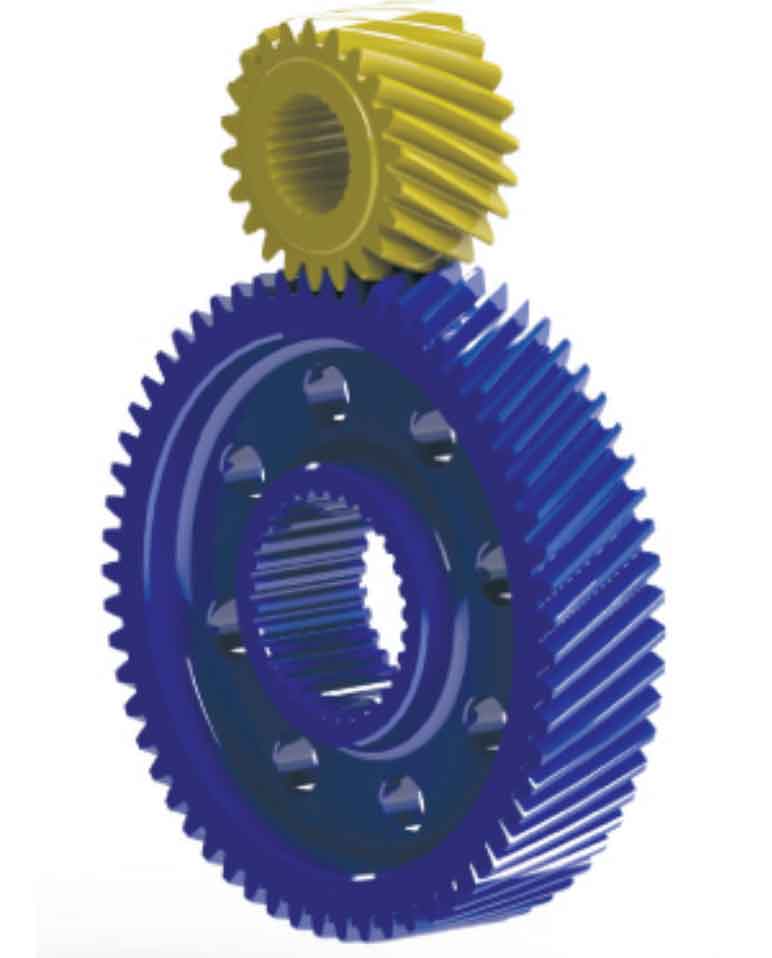The design and optimization of helical gears are often complicated, and even involve the solution of some transcendental equations. Therefore, scholars use some professional finite element simulation software to simplify the complex engineering problems of helical gears.
At present, the research and application of finite element simulation for helical gears are numerous and very mature. At home, Li Gang established a three-dimensional model of the output stage gear pair of high-speed EMUs through UG, completed the stress and strain calculation of helical gear teeth under constant load in the static module of ABAQUS software, and proposed to use such technological means as laser shock, rolling, shot peening or reasonable modification of the gear tooth top to strengthen the residual compressive stress on the gear tooth surface, so as to improve the fatigue life of helical gears. Fan Shuyang completed the second development of ADAMS software for the analysis and calculation of helical gear dynamic response and contact characteristics based on gear tooth contact theory on the basis of measuring the precise tooth profile of helical gear, and obtained the data of helical gear tooth surface bending stress and contact stress under specific working conditions. Li Yao simulated the real meshing process of helical gear pair with ANSYS, and found the temperature field distribution characteristics of gear tooth surface. The results show that the tooth surface temperature of helical gears is greatly affected by the friction coefficient, and the temperature in the middle of the tooth surface is the highest. Shi Pengzhen used KISSsoft simulation software to carry out modification research on the meshing contact performance of the helical gear pair tooth surface, and believed that the meshing performance of the helical gear pair after optimized modification was improved, and its tooth surface contact stress, transmission error, temperature and tooth root bending stress were significantly reduced. Peng Y used finite element simulation technology to study the influence of gear modification and dislocation on the tribological performance of helical gears, and based on the elastohydrodynamic lubrication theory, established a non Newtonian thermal elastohydrodynamic lubrication helical gear model considering gear modification and dislocation. The results show that the drum profile modification can improve the lubrication performance of the meshing helical gear pair and increase the tolerance of gear misalignment.

In foreign countries, Shanmugasundaram S found that the medium speed or high speed gears in the wind turbine generator set often fail first due to the effects of air flow, frequent voltage drops and gusts when using KISSsoft and ANSYS software to study the failure of helical gears in the speed increase gearbox of the wind turbine generator set. Therefore, after fully evaluating the bending stress and stiffness of helical gear teeth, Shanmugasundaram S proposed a gear micro geometric structure that can enable the helical gear of wind turbine to rotate without failure, that is, at the same time, the tooth top of helical gear is modified and the pressure angle is changed. Klock F et al. used Deform-3D software to simulate the fine blanking process of helical gears. They believed that the helix angle was the key factor affecting the performance and surface stress distribution of the helical gears to be machined, and the weight would change with the change of the tooth section. Patil S S et al. carried out numerical simulation analysis on static contact stress between helical gear pairs through commercial software ANSYS, and explored the variation law of tooth surface contact stress with helix angle and average friction coefficient within the range of 0~0.3 of average friction coefficient. The results show that with the increase of friction coefficient, the increase of contact stress of helical gears with larger helix angle is greater than that of helical gears with smaller helix angle. Lim J simulated the change of tooth profile of helical gear after quenching by using three-dimensional elastic-plastic finite element method, studied the change of tooth profile size of helical gear after heat treatment, and finally carried out experimental demonstration. Patil P J et al. combined the finite element method with the theory, studied the relationship between the pressure angle, helix angle and the bending stress of the tooth root of the helical gear under the dynamic loading condition, and determined the optimal weight torque ratio of the gear transmission system under this working condition through the optimization of the dynamic model.
